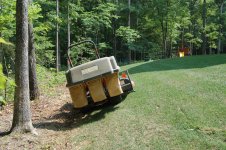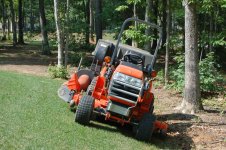You have to calibrate it. Jack up one side of the tractor while wathcing the tilt meter until the tractor tips over. Then mark that spot.
Now I hope you all know I'm KIDDING.
All good advice above.
I know you are kidding, but that is one idea. I have mine on a couple of really steep angles. And once I was able to get the seat out of my cheeks I decided not to do that again.
The tilt meter could make you a little over confident. I mow on some steep hills and usually never had a problem until onde day a pring decided to surface in a spot that never had one. The tractor slid down the hill sideways and when it stopped, it almost tipped over. I'm sure that that won't happen to probably anyone, but the point is that even in places that you have been across before can be dangerous.
When I first got my tractor it felt like it was going to flip over all the time. Made it really hard to use the tractor. So I decided that I would drive it onto a hill, get of (on the up hill side) and see if the tractor would tip over, if it didn't then I would get back on it and have my wife see if it would tip. I was playing on the theory that if it just needed a little to tip, just a little would keep it from tipping over. It helped to give me a little confidence in the tractors abilities.
In the really steep parts I go at an angle just enough to be safe, but enough that I don't have to keep doing the front to back up and down the hill all over the place.
Like others have said, a little bump on the up hill or a depression on the down hill will totally make the tilt meter worthless if you are solely looking at it. If you are going to look at anything, watch your front tires, especially the up hill side, that is going to give you a better indication that you are about to be in trouble.
One last final bit of advice, leave the BH and FEL off, it does raise the center of gravity even more and make it a whole lot more dangerous IMHO.


